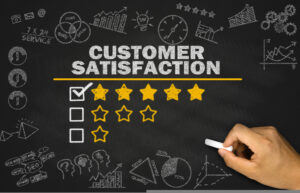Just when grocery stores started thinking about how terrible their plastic bags are and Starbucks comes along with paper straws, Amazon shows up and says, “move out of the way, we’ve got boxes.”
It’s kind of cliché, but have you ever come home from work, and seen 10 amazon boxes on your front porch? We always need wipes for our son and whenever we order wipes from amazon, they come in 9 separate wipe bags, shrink-wrapped in plastic, inside a box labeled with the brand of amazon wipes, inside another box branded with whatever Amazon is trying to sell at the time. This is objectively a lot of waste for one package.
Ultimate Benefits of Sustainability
Well, for one, our species may continue to happily live on this rock floating through space a little longer. But there is a cost to being sustainable. The upfront cost of sustainability can be difficult to manage for some companies. Slowly switching the lights to LED in my own home cost me a small fortune.
Gen Z is more concerned about the environment and sustainability than any generation yet. Consumers are starting to care about the level of effort businesses put into protecting the environment. 75% of the Gen Z population think sustainable purchases are more important than brand names. 67% of Millennials prefer to buy from sustainable brands.
Consumers are looking for companies contributing to improving the environment. Sustainability is about offsetting negative impacts on the climate, not just decreasing the company’s mark. Consumers are looking for companies that care about the Earth. Investing time and money into a sustainability plan can make a business more trusted by their consumer, especially if the plan and progress are transparent to the consumer.
How do you find sustainable products?
Sustainable isn’t a government-regulated word like organic is. In order to label your company or product sustainable, you just have to be able to back it up, to not mislead consumers. That means as consumers, it is your job to research how “sustainable” a company is.
Companies that want to be known as sustainable or less impactful on the environment are being transparent with their initiatives. Patagonia has donated its entire company to fight climate change and expects to donate about $100 million each year depending on the health of the business. Their mission statement encapsulates the idea of sustainability. “Build the best product, cause no unnecessary harm, use business to protect nature, and not bound by convention.”
They make the warmest jackets, 87% of their clothing is made from recycled products, they donate to help fight climate change, and I’ll go ahead and say it’s unconventional to donate your entire company to a cause. Everyone can’t donate their company to a cause, but they can have a transparent plan of what sustainability means to them and how they are trying to help. You can find Patagonia’s sustainability plan right on their website.
What can companies do to be more sustainable?
Reduce Office Waste
- Decrease the use of single-use items in the office
- Encourage employees to recycle
- Buy sustainable products for office use
- Change lightbulbs to LED
- Set goals to incentivize employees to use fewer single-use items or to recycle and reward these goals.
Reduce Unnecessary Travel
There is something to be said about a face-to-face meeting. It’s not something that can ever be cut out completely, but it’s not something that is always a necessity.
- Reduce air travel when unnecessary. Air travel is a large contributor to global warming, accounting for 5% of CO2 emissions.
- Reduce travel in general. People can work from home when necessary or join meetings virtually.
- Incentivize the use of mass transit when possible.
Sustainable Companies in 2022
Here are a couple of companies making the effort to be more sustainable in 2022.
Meta
The company formerly known as Facebook has in the past offered $10,000 to those who are willing to live within 10 miles of the office. Not every company has $10,000 to give away for the environment, even though it is a good cause to stand by. They allow a majority of their employees to continue working from home. In 2020, they were able to announce that their global operations have reached net zero emissions and they are supported by 100% renewable energy.
Clif Bar
This popular protein bar company has pledged that by 2025 all their packaging will be reusable, recyclable or compostable. They have outsourced more than a billion pounds of organic ingredients and continue to divert more waste from landfills each year.
Yeti
Yeti has eliminated 355 tons of packaging waste since 2018. They continue to support communities, donating over $2 million to organizations and foundations on conservation in the wild. Yeti has goals to reduce Scope 1 and Scope 2 carbon emissions by 50% and Scope 3 emissions by 27%. Scope 1 and 2 emissions are emissions caused directly by the company while Scope 3 emissions are a result of the company’s activity but not necessarily created by them.
GoMacro
GoMacro is another company that has operations powered by 100% renewable energy. They have diverted 64% of their waste from landfills and their consumer packaging is 100% recyclable or compostable. They are a 100% carbon-neutral company.
Allbirds
Allbirds is a newer fashion company that sells shoes. They have introduced carbon footprint labels onto their clothing, sort of like a nutrition label but for carbon. They are now selling this carbon footprint labeling system as a proprietary technology for other companies. In 2021 they introduced their 110% natural plant leather which has a carbon footprint of 40x less than traditional leather.
How to become sustainable
Spend time researching how to make a product or service more sustainable. Start by looking at the impact the company currently has on the environment. Sustainability should be taken one step at a time. It’s not about overhauling the entire company; it’s about heading in the right direction.
Sustainability is sort of a buzzword right now. Every company wants to tell you about how they are doing great things for the environment. That’s why it is up to the consumer to hold these companies accountable for their actions and make sure that companies are doing what they are claiming to do. Companies must decide how to tell their consumers about their sustainability initiatives. If they get caught exaggerating or leaving information out, consumers of this day and age will find out.
Investing in sustainability is investing in your brand, the world, and the future. Don’t let a product become obsolete as something that has a negative impact on the Earth. The younger generations care, and they have their parents’ and grandparents’ ears. Make sure they have something good to say.















